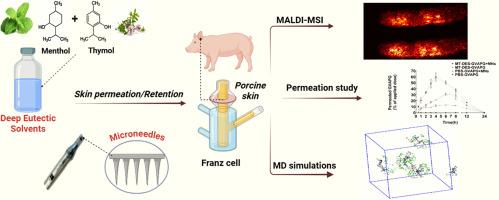探索薄荷-百里香酚深共溶溶剂与固体微针联合用于皮肤肽递送的潜力。
IF 4.7
3区 医学
Q1 PHARMACOLOGY & PHARMACY
引用次数: 0
摘要
虽然像肽这样的生物活性分子的皮肤给药通过绕过第一次代谢和提高生物利用度比口服给药有优势,但它也有一些挑战,主要是由于肽的亲水性和高分子量导致的亲脂性角质层对肽的吸收较差。最近,深共晶溶剂(DESs)作为一种新的化学渗透促进剂引起了人们的关注,它通过破坏角质层内的脂质组织来促进药物在皮肤上的传递,从而显著改善药物在更深皮肤层的渗透。本研究使用薄荷-百里酚DES (MT-DES)研究了五肽GVAPG在猪皮肤中的渗透,单独使用和与固体微针(MNs)联合使用作为物理渗透增强剂,以评估化学和物理增强剂的联合使用是否比单独使用提供额外的益处。与单独使用任何一种增强剂相比,MT-DES和MNs联合使用可显著增强GVAPG的通透性。稳定性测试表明,与磷酸盐缓冲盐水相比,MT-DES减少了皮肤蛋白水解酶引起的肽降解。基质辅助激光解吸/电离质谱成像显示GVAPG及其降解产物在皮肤上均匀分布。分子动力学模拟表明,GVAPG在MT-DES中呈细长构象,与水相比,与MT-DES的氢键较少,这可能有助于GVAPG从配方中解放出来并改善渗透。总的来说,这些发现表明MT-DES和MNs结合是一种很有前途的策略,可以增强肽的渗透和稳定性,并可能减少应用频率。然而,需要对其他多肽进行进一步的研究来证实这些结果。本文章由计算机程序翻译,如有差异,请以英文原文为准。

Exploring the potential of combining menthol-thymol deep eutectic solvent and solid microneedles for cutaneous peptide delivery
While cutaneous administration of bioactive molecules like peptides offers advantages over oral delivery by bypassing first-pass metabolism and increasing bioavailability, it also comes with some challenges, primarily due to poor peptide absorption through the lipophilic stratum corneum, as a result of peptide hydrophilicity and high molecular weight. Recently, deep eutectic solvents (DESs) have gained attention as a new subclass of chemical permeation enhancers, facilitating drug delivery across the skin by disrupting the lipid organization within the stratum corneum, thereby significantly improving drug permeation into deeper skin layers. This study investigated the permeation of the pentapeptide GVAPG in porcine skin using a menthol-thymol DES (MT-DES), both alone and in combination with solid microneedles (MNs) as a physical permeation enhancer, to assess whether the combined use of both chemical and physical enhancers offers additional benefits over individual application. The combination of MT-DES and MNs significantly enhanced GVAPG permeation compared to either enhancer alone. Stability testing showed that MT-DES reduced peptide degradation caused by the skin proteolytic enzymes compared to phosphate-buffered saline. Matrix-assisted laser desorption/ionization mass spectrometry imaging revealed an even distribution of GVAPG and its degradation products across the skin. Molecular dynamics simulations indicated that GVAPG adopted an elongated conformation in MT-DES, with fewer hydrogen bonds with MT-DES as compared to water, which may potentially contribute to an enhanced liberation of GVAPG from the formulation and improved permeation. Overall, these findings suggest that combining MT-DES and MNs is a promising strategy to enhance peptide permeation and stability, potentially reducing application frequency. However, further studies with other peptides are needed to confirm these results.
求助全文
通过发布文献求助,成功后即可免费获取论文全文。
去求助
来源期刊
CiteScore
9.60
自引率
2.20%
发文量
248
审稿时长
50 days
期刊介绍:
The journal publishes research articles, review articles and scientific commentaries on all aspects of the pharmaceutical sciences with emphasis on conceptual novelty and scientific quality. The Editors welcome articles in this multidisciplinary field, with a focus on topics relevant for drug discovery and development.
More specifically, the Journal publishes reports on medicinal chemistry, pharmacology, drug absorption and metabolism, pharmacokinetics and pharmacodynamics, pharmaceutical and biomedical analysis, drug delivery (including gene delivery), drug targeting, pharmaceutical technology, pharmaceutical biotechnology and clinical drug evaluation. The journal will typically not give priority to manuscripts focusing primarily on organic synthesis, natural products, adaptation of analytical approaches, or discussions pertaining to drug policy making.
Scientific commentaries and review articles are generally by invitation only or by consent of the Editors. Proceedings of scientific meetings may be published as special issues or supplements to the Journal.

 求助内容:
求助内容: 应助结果提醒方式:
应助结果提醒方式:


